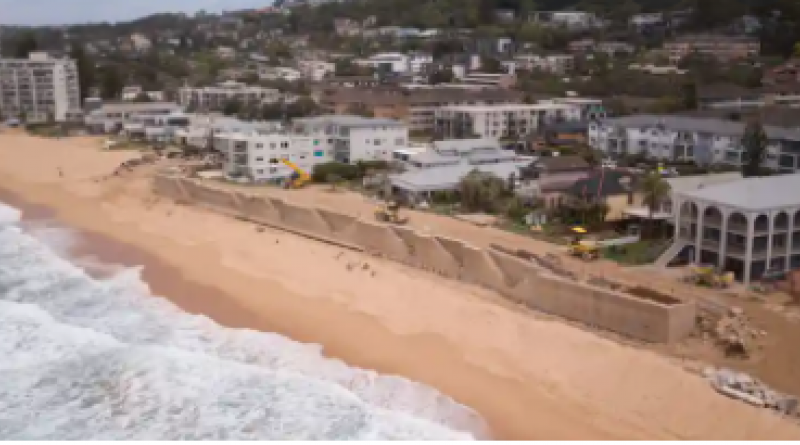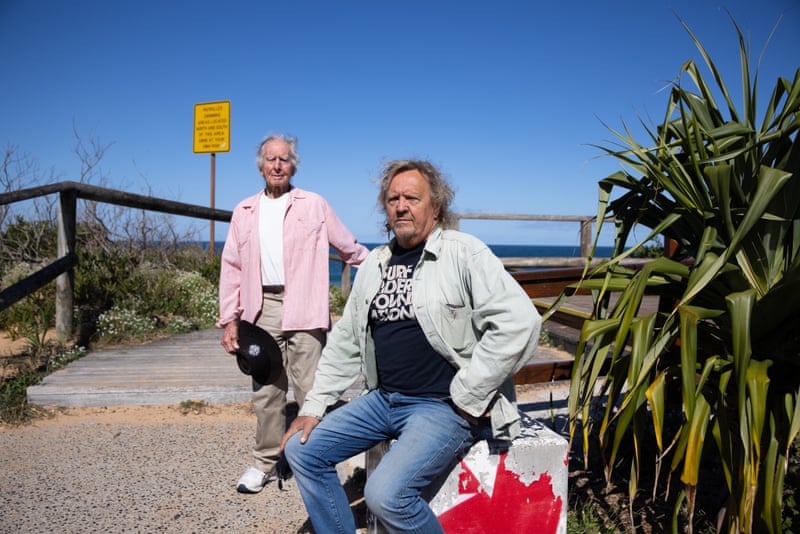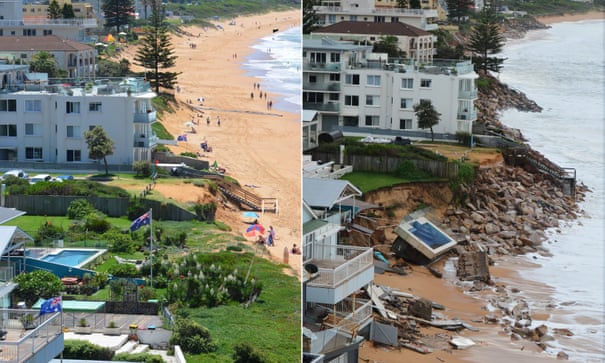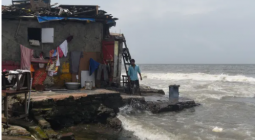A 7m wall has gone up on a Sydney beach: are we destroying public space to save private property?

Beachfront residents back the Collaroy wall but other locals worry the beach will disappear for longer periods as climate change increasingly drives coastal erosion.
“We really didn’t want to build a wall,” says Bob Orth.
But Orth is one of 10 residents of Collaroy, on Sydney’s northern beaches, who have each paid $300,000 to do just that.
And not just any wall. Construction began in December on a seven-metre-high sheer concrete structure below the residents’ properties, which overlook a beach that has become notorious for dramatic erosion every time there is a big storm.
When the wall is complete it will snake its way 1.3km up the coast to South Narrabeen, consisting of a vertical concrete wall in parts and a revetment – a sloping rock structure engineered to absorb wave energy – in others. Over its projected 60-year lifespan it will hold back the tides to protect 49 properties, 11 public land areas, a surf life saving club and a car park.
Residents, including Orth, will cover 80% of the cost, with the rest paid for by the New South Wales government and the Northern Beaches council.
“We didn’t want to put up $300,000,” Orth says. “But we had to build a wall and we’ve done it strictly by the book.”


Collaroy is no stranger to storms – the author Ruth Park sketched a vivid first-hand account of one when she lived in the area in 1945 – and the most famous one hit in 2016, when monster waves swept up the beach and washed away the shore, tearing a private pool from its moorings and leaving houses teetering on the brink.
In the five years since, during which two further storms have hit the beach, the residents along the worst-hit strip have organised by forming a corporation, contracting Horton Coastal Engineering to design a wall and campaigning successfully for council approval.
“Without the wall built here, we’d be ripped into with the next storm,” Orth says. “I haven’t got a doubt in the world [that it will work], and no one has any doubts along here. The owners are very happy with the solution.”
‘Brutal engineering solution’
Others in Collaroy are far from happy. Brendan Donohoe from Surfrider Foundation is a local whose organisation has been fighting against the construction of a seawall for three decades. He says that by building the vertical wall, the council is sacrificing the beach to protect private property.
“The council was honestly shocked we weren’t delighted. We were honestly astounded at what they’ve done,” Donohoe says.
As beaches are dynamic systems, changes to the physical environment – such as building on dunes or on the beach itself – can interrupt natural processes by which sand moves around, causing it to disappear from some areas while building up in others.
Donohoe fears the sand directly in front of the wall will be washed away in the next storm, and without a renourishment program to artificially replace it, that section of beach will disappear for longer periods.
“Ultimately these properties are probably unprotectable,” he says. “Our beach is the thing we should be trying to insure – not in the monetary sense but in the sense of its continued existence.”

Angus Gordon, a coastal engineer and former general manager of Pittwater council, says a vertical wall is a “brutal engineering solution” to a problem that would have been better addressed by a rock revetment.
“Basically, building an artificial cliff face in front of the beach is not fitting in with the environment,” Gordon says.
But Ray Brownlee, the chief executive of Northern Beaches council, rejects the criticism, saying the design of the wall was reviewed by a Danish coastal engineer, the Manly Hydraulics Laboratory and a team from the University of New South Wales.
He says the vertical wall has a smaller footprint on that section of beach than a rock revetment would have had. When finished, two-thirds of the structure will be buried “most of the time”, he says.
“Council’s priority has always been to support residents to protect their properties as long as there is no negative impact on the beach,” Brownlee says. “Our challenge, and that faced by coastal areas around Australia, is to manage the impact of planning decisions made over a century ago.”
Climate change drives coastal erosion
Collaroy and Narrabeen certainly aren’t the only Australian communities facing competing demands as climate change increasingly drives coastal erosion.
Storms in late 2020 and mid-2021 wiped away the sand at Main beach in Byron Bay in northern NSW, while a surf life saving club at Inverloch in Victoria has been forced to retreat twice from advancing tides.
In Western Australia, storms lashed Fremantle’s Port beach in 2019, leaving buildings on the edge of collapse, while Post Office Rock in Beachport, South Australia is recognised as one of Australia’s fastest eroding beaches.
Some 135 metres of land has been lost since 1946 along that stretch of South Australian coastline, with the ocean expected to punch through the dunes in the next decade and reclaim the Pool of Siloam, a popular tourist destination.


Most of the time this erosion occurs in remote places but increasingly it is affecting areas of high development too.
A review conducted in 2009 by the then Department of Climate Change and Energy Efficiency, found that up to 247,600 homes were at risk of inundation if sea levels rose by 1.1 metres. A follow-up in 2011 identified thousands of additional commercial and industrial buildings that were vulnerable.
Some local councils, such as Fremantle in WA, have adopted policies of “managed retreat”, but often they have not been coupled with buy-back schemes to remove vulnerable houses without financially crippling the owners.
State governments have been reluctant to step in, leading many property owners to call for the construction of seawalls to defend homes and businesses.
While these structures may temporarily stem the advancing ocean, they sacrifice the beach for short-term security.
‘We’re already paying for it’
Since 1901 the world’s oceans have risen 20cm on average, but the effect has not been felt evenly.
The reasons are complex and range from epochal shifts in tectonic plates that cause one region to rise and another to fall, while human activity can make an area more flood-prone.
The Australian coastline has been relatively stable, according to Robbi Bishop-Taylor of Geoscience Australia, who helped build a tool that uses satellite data taken since the 1980s to map changes in the coast.
He says just 21% of Australian coastlines have experienced erosion in the past three decades.
“The reason for this is often a lot more complicated than pure erosion or growth,” Bishop-Taylor says.
Even in areas where change has been dramatic, erosion in one area can be offset by gains in others.

Bishop-Taylor says Point Stuart, a marshy area near Darwin, has lost roughly 500 metres over three decades, but this erosion was balanced by growth in the Gulf of Carpentaria, where the land is growing at a rate of 10 metres a year.
However, climate change is increasing the rate of sea level rise.
According to the IPCC6 report published in August, those born in 1971 have watched the world’s oceans rise at a rate of 1.9mm a year. For those born after 2006, that rate has nearly doubled.
Associate prof Ruth Reef, from Monash University’s school of earth atmosphere and environment, says those numbers may sound small, but as a general rule 1cm of sea level rise causes a one metre retreat of the coastline on beaches.
“The relationship is not one-to-one because the beach is on a slope,” Reef says.
This process is exacerbated as climate change disrupts normal wind patterns, changing how much energy can whip up waves, particularly during storms.
“We keep thinking about climate as something that will happen, but it’s happening already,” Park says. “We’re already seeing impact and we’re already paying for it – but we’ll see a lot more of it because sea levels are rising.”
23 October 2021
The Guardian




